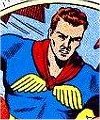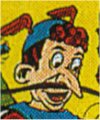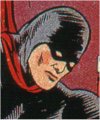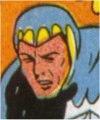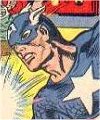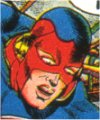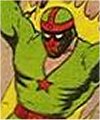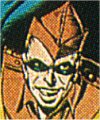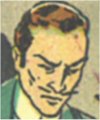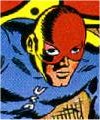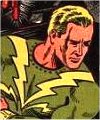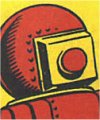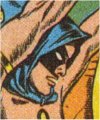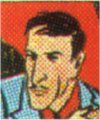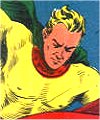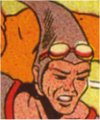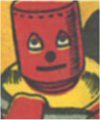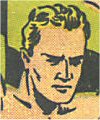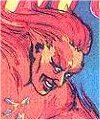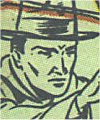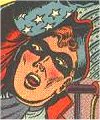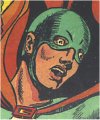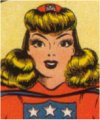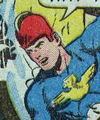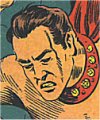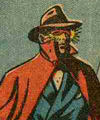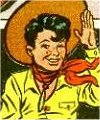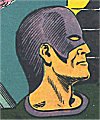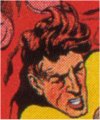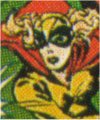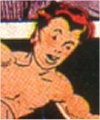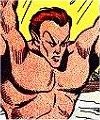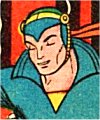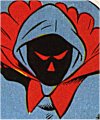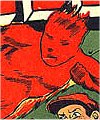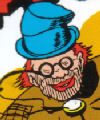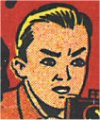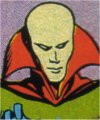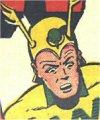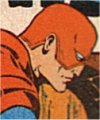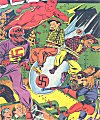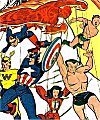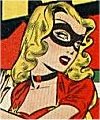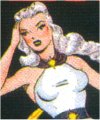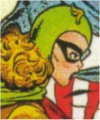Timely Comics
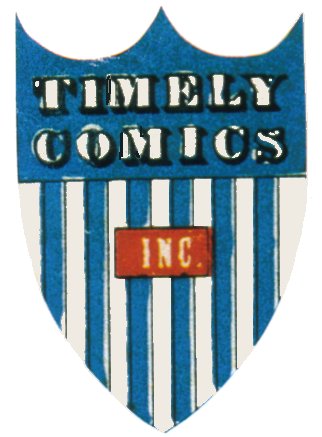 Originally
known as Red Circle Comics, the company which would become better known as
Timely Comics (and latterly as Marvel Comics) was founded by Martin Goodman
in 1939, and debuted with the launch of Marvel Comics #1. Goodman had previously
published pulp magazines (which is where the Red Circle name came from),
covering the full gamut of genres of the era - western, detective, science
fiction, jungle adventure and so on. In 1939 Goodman was looking for new
markets to expand into - he was a publisher looking for stories. As luck
would have it, he made the acquaintance of Frank Torpey, a salesman working
for Funnies Incorporated, a group of creators looking for a publisher.
Originally
known as Red Circle Comics, the company which would become better known as
Timely Comics (and latterly as Marvel Comics) was founded by Martin Goodman
in 1939, and debuted with the launch of Marvel Comics #1. Goodman had previously
published pulp magazines (which is where the Red Circle name came from),
covering the full gamut of genres of the era - western, detective, science
fiction, jungle adventure and so on. In 1939 Goodman was looking for new
markets to expand into - he was a publisher looking for stories. As luck
would have it, he made the acquaintance of Frank Torpey, a salesman working
for Funnies Incorporated, a group of creators looking for a publisher.
At this point in time, the comics field in the U.S. consisted predominately
of four publishing companies - Fox Features
Syndicate, Centaur Publishers,
All-American Comics and
National Periodicals (the
latter two of whom would later form D.C. Comics).
Funnies, Inc. was formed from former staff of Centaur who had left their
old jobs with the dreams of foudning their own publishing company. Lacking
the finances to do this, they fell back to the option of creating stories
for others to own and publish. Since the existing four comic companies already
had creative teams producing work for them to publish, Funnies, Inc needed
to find someone new.
Marvel Comics, named after Goodman's science-fiction pulp title Marvel Science
Stories, saw the introduction of Timely's first superheroes, The Human Torch
and The Angel. Ironically, two other heroes in Marvel Comics #1 who were
later to be closely associated with Timely / Marvel Comics, the Sub-Mariner
and Ka-Zar, actually pre-date the company (see individual entries). Retitled
Marvel Mystery Comics with issue 2, the title was a success, and was soon
joined on the stands by other titles, such as Daring Mystery Comics. As Goodman's
pulps line faded away due to poor sales, his Timely Comics slowly grew. None
of the new titles had the success of Marvel Mystery Comics, and Timely might
have ended up as just a minor footnote in comics history, had it not been
for an idea of two members of the creative team, Bill Everett and Carl Burgos.
They decided to have their respective heroes, the Human Torch and the
Sub-Mariner, encounter one another and fight, a first for comics, and one
that laid the initial building blocks for what would one day become the Marvel
Universe. This (for the time) radical concept placed Timely firmly on the
map, and saw sales soar, though the company was still small fish compared
to the industries' biggies, DC, Fawcett and
Quality.
Through the war years Timely rose in eminence as a publisher, helped in no
small part by the creation of Captain America, who became their flagship
character. However, like their rivals, Timely experienced a sharp down turn
in the fortunes of their superhero titles by the end of the decade, caused
in large parts by the changing economics of a post-war America. They shifted
their focus to other genres.
Another change had happened as the decade progressed. Timely had added a
"patriotic shield" to the covers of many of their titles during the war,
but this practice died away as time passed. Towards the end of the forties,
several of their titles had the logo "Marvel Comic" on them (the final issues
of Sub-Mariner Comics, The Human Torch and Captain America [by now retitled
Captain America' Weird Tales] all carried this), and the company had basically
become Marvel Comics. However, rightly or wrongly, this was not the name
that would be associated with them during the subsequent decade. Martin Goodman
decided to maximise profits by breaking away from his then-distributor, Kable
News, and set up his own distribution company, Atlas News Company, itself
a subsidiary of Atlas Publishing. Goodman grouped several companies under
this overall banner, including his magazine lines, and, importantly, his
comic publishing ventures. By the end of 1951 every title carried an Atlas
logo, not a Marvel logo. As a result, however erroneously, the Marvel Comics
of the 1950's became known as Atlas Comics.
For a more in-depth history of Timely Comics online, I highly recommend Jess
Nevins
"Timely
Comics Story".
Years later, in the 1960's, Marvel began its big revival and rise to the
position of most successful comic book company of them all. At that point
some of the Timely characters were revived and brought into this new universe,
in much the same manner that D.C. revived their headliners of that past era.
D.C. eventually re-started their characters' universe, designating the old
stories as having taken place on "Earth-2", in another dimension. Marvel
took a different stance. The rule of thumb regarding their characters' earlier
adventures became "They probably happened much as they were presented, but
not all of them exactly as the comics of the time showed them. Unless and
until a modern story confirms them, they are in limbo." Some of the old
characters returned to the newstands virtually unchanged, some got only cameos
or mentions to acknowledge they had been part of Marvel's history, some underwent
significant revisions that established them as virtually new characters,
and many have not resurfaced to this day. Please note that while most of
these characters were seen to be adventurers in the same era they were published
in (e.g. they fought crime and the Axis in the 1940's), some had stories
set in other eras (such as the Wild West of the 1880's).
Thanks to Jess Nevins for allowing me to use information from his excellent
Golden Age Heroes
Directory and his
Guide
to Golden Age Marvel Characters. Thanks also to Richard Boucher &
Darrin Wiltshire @ PR-Publications for permission to use information from
their equally brilliant collection of Golden Age Sites,
PR Publications. Their knowledge
of Golden Age characters far outstrips my own.
Western
Romance, Humour and Funny Animals
Horror Comics and Monster Characters
Heroes whose adventures were set in other
eras
World War II Adventurers
Post-War, late 1940s Adventurers
Back to US Independents Page
Home
All images and characters depicted on this site are copyright their respective
holders, and are used for informational purposes only. No infringement is
intended and copyrights remain at source.
 Originally
known as Red Circle Comics, the company which would become better known as
Timely Comics (and latterly as Marvel Comics) was founded by Martin Goodman
in 1939, and debuted with the launch of Marvel Comics #1. Goodman had previously
published pulp magazines (which is where the Red Circle name came from),
covering the full gamut of genres of the era - western, detective, science
fiction, jungle adventure and so on. In 1939 Goodman was looking for new
markets to expand into - he was a publisher looking for stories. As luck
would have it, he made the acquaintance of Frank Torpey, a salesman working
for Funnies Incorporated, a group of creators looking for a publisher.
Originally
known as Red Circle Comics, the company which would become better known as
Timely Comics (and latterly as Marvel Comics) was founded by Martin Goodman
in 1939, and debuted with the launch of Marvel Comics #1. Goodman had previously
published pulp magazines (which is where the Red Circle name came from),
covering the full gamut of genres of the era - western, detective, science
fiction, jungle adventure and so on. In 1939 Goodman was looking for new
markets to expand into - he was a publisher looking for stories. As luck
would have it, he made the acquaintance of Frank Torpey, a salesman working
for Funnies Incorporated, a group of creators looking for a publisher.

